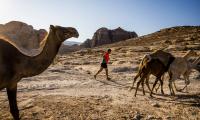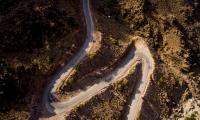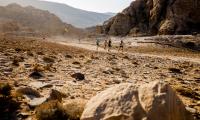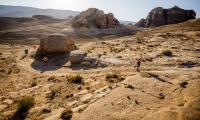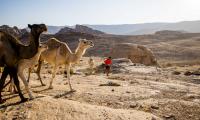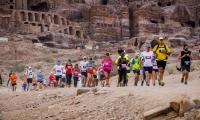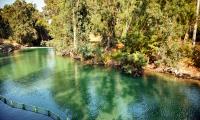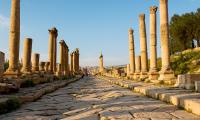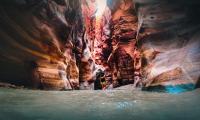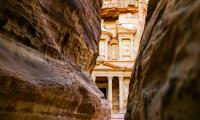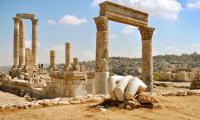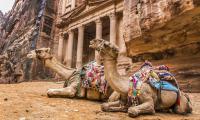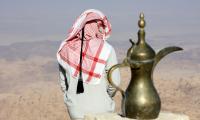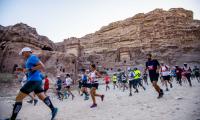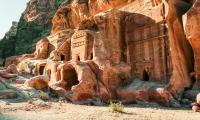Travel to Jordan
From a lavish town of ruins hidden in the middle of the desert to a giant salt lake where one can float like a leaf, there are adventures galore in this middle eastern gem. Adventurous travelers can explore the desert of Wadi Rum – made famous by Lawrence of Arabia – or discover the living biblical history in the heart of The Holy Land. Add to that delicious cuisine and exceptionally hospitable people, and Jordan is a journey worth taking.
The Location
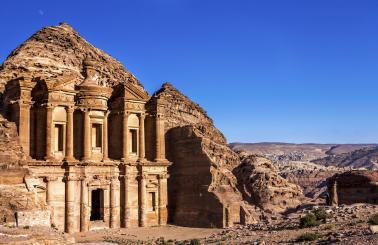 Petra
Petra
Understandably, the biggest attraction in Jordan is the UNESCO World Heritage site of Petra. Named one of the New 7 Wonders of the World, this towering city of ruins contains lofty buildings carved directly into reddish sandstone cliffs. Petra was the capital of the Nabatean Kingdom from 4th century B.C. until roughly 100 A.D., when Romans captured the city. After this, the city declined rapidly and was soon abandoned. It was left alone among the desert’s cliffs for centuries, until, in 1812, Swiss explorer Johann Burckhardt pursued rumors of a lost city and persuaded his Bedouin guide to show him the secret path through the cliffs.
Today, visitors can see hundreds of temples and tombs. Only the facades are visible, but the rooms actually extend far back into the depths of the stone. Petra also contains an extremely beautiful monastery, a huge circular amphitheater, and, of course, its most famous building: Al Khazneh, also known as The Treasury. This 40-meter-high, ornate façade is the first sight to greet visitors after the 1,2 km walk down the Siq – the narrow gorge that is the only entrance to Petra. With so much to see, a visit to Petra can easily consume several days.
Amman
The capital of Jordan is the bustling city of Amman. Amman weaves a rich tapestry of Jordanian culture, showcasing both its traditional, conservative side as well as international, modern influences. One of the oldest continuously inhabited cities in the world, Amman has been populated since the Bronze Age and has gone through many incarnations, from a Greco-Roman city of the Decapolis to modern day Islamic Amman, which was settled by the Ottoman Empire.
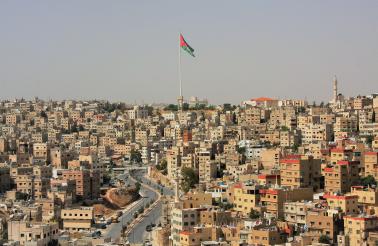
Initially built on 7 hills, Amman was designated the capital in 1921 and subsequently experienced rapid growth, spreading the suburbs to eventually cover 19 hills. One can visit the Citadel, perched on the highest hill in Amman, or head down in the valley and explore a vibrant downtown district, where contemporary cafes mix with mosques and souqs. East Amman features ancient historical sites that commonly host cultural activities, while West Amman acts as the economic hub of the capital, with modern buildings, bars, and malls.
Amman also functions as an excellent jumping-off point for the rest of the country’s attractions. Visitors flock to the nearby cities of Jerash and as-Salt, while the neighboring Dead Sea offers a sweet release from summer’s sweltering heat.
Jerash
Less than an hour outside of Amman, the city of Jerash offers Roman ruins that rival Rome itself. Today, Jerash is composed of both a modern city and the historical Greco-Roman ruins. Greek inscriptions found in the city suggest that Alexander the Great himself founded the settlement before it was annexed as part of the Roman Empire under General Pompey. As a Roman entity, Jerash flourished, and built many recognizable architectural features: a triumphal arch, colonnaded streets, amphitheaters, and more. These ruins were buried under sand for many centuries, and thus are extremely well-preserved – visitors can wander through original stone streets, visibly rutted from the chariots that traversed them, and marvel at the ghosts of times past.
History and Culture
History
Today known as the Hashemite Kingdom of Jordan, the area that Jordan occupies has been home to some of mankind’s earliest settlements. Its location at the crossroads of Asia, Africa, and Europe means Jordan has played an important role in world trade, and has seen many civilizations rise and fall. In the late Bronze Age, four kingdoms developed that would dominate most of the Iron Age: the Moabites, Edomites, Ammonites, and Israelites. The Nabatean Kingdom also emerged toward the end of the Iron Age, and established Petra as their capital city.
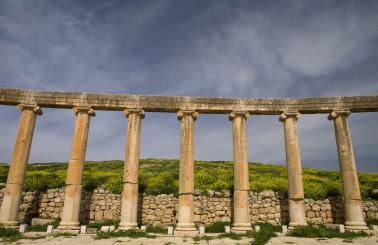 The Nabateans existed independently until 106 AD, when they were annexed into the expanding Roman Empire. Modern Jordan is rich in ruins from these ancient times – in addition to the famous Petra, the country is home to an impressive collection of Greek, Hellenistic, and Roman remains. Following the dissolution of the Roman Empire, the region of Transjordan was ruled by a series of Muslim empires until the Ottoman Empire established dominance. In the early 1900s, the Ottoman Empire pursued a policy of secular Turkish nationalism, which fed growing discontent among the Arab population. This culminated in the Great Arab Revolt during World War I and the subsequent fall of the Ottoman Empire.
The Nabateans existed independently until 106 AD, when they were annexed into the expanding Roman Empire. Modern Jordan is rich in ruins from these ancient times – in addition to the famous Petra, the country is home to an impressive collection of Greek, Hellenistic, and Roman remains. Following the dissolution of the Roman Empire, the region of Transjordan was ruled by a series of Muslim empires until the Ottoman Empire established dominance. In the early 1900s, the Ottoman Empire pursued a policy of secular Turkish nationalism, which fed growing discontent among the Arab population. This culminated in the Great Arab Revolt during World War I and the subsequent fall of the Ottoman Empire.
The Great Arab Revolt was led by Sharif Hussein and his sons, Abdullah and Faisal. Although the Arab forces were promised autonomous rule, the Allied powers instead divided up the region into various protectorates, with Jordan falling under Britain’s mandate. Sharif Hussein’s son Abdullah ruled the British Emirate of Transjordan as Emir until 1946, when he became King Abdullah I of the independent Hashemite Kingdom of Transjordan (Transjordan was shortened to Jordan in 1949).
The second half of the century was turbulent, with coups and small wars being a regular occurrence. King Hussein (Abdullah I’s grandson) took the throne in 1953, and, with his pragmatic and western-friendly leadership style, laid the groundwork for Jordan’s characteristic peace today. This was solidified by the Israel-Jordan Treaty of Peace, signed in 1994. In 1999, upon King Hussein’s death, his son Abdullah II ascended the throne and remains in power.
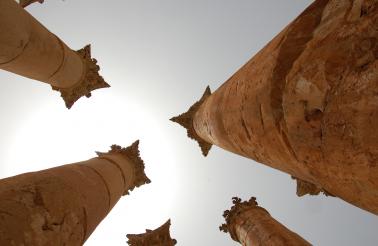 The last 20 years have seen Jordan prosper under King Abdullah II’s reign. His rule is characterized by economic liberalization, peaceful foreign relations, political and civil liberty, and electoral reform, including introducing a rule that at least 20% of local politicians must be women. He has also concentrated heavily on education and healthcare reforms, and the result is a country that is peaceful, modern, and content.
The last 20 years have seen Jordan prosper under King Abdullah II’s reign. His rule is characterized by economic liberalization, peaceful foreign relations, political and civil liberty, and electoral reform, including introducing a rule that at least 20% of local politicians must be women. He has also concentrated heavily on education and healthcare reforms, and the result is a country that is peaceful, modern, and content.
One should also note that for centuries, some of Jordan’s people lived as nomads, and to this day, there is a minority population - known as the Bedouins - that still live a nomadic or half-nomadic lifestyle in the desert and the steppes of Jordan. The Bedouins have a distinct culture that emphasizes generous hospitality, and they are happy to open their tents to host the curious traveler.
Religion and Biblical Sites
The population in Jordan is predominantly Muslim, and the official state religion is Islam. The vast majority of people ascribe to Sunni Islam, with only a small number of Shiites. That being said, Jordan allows for freedom of religion, and a significant Christian minority coexists peacefully in the country. In fact, Jordan has one of the oldest Christian communities in the world.
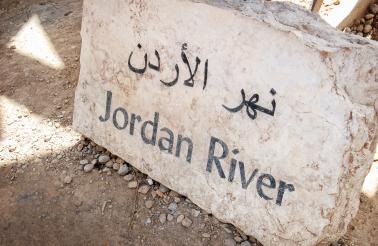 The Christian community is present because this is the region that inspires their faith. Located in the heart of The Holy Land, Jordan is the setting for several stories told in the Bible. The most revered holy site is Mount Nebo, where Moses viewed the Holy Land of Canaan before finding his final resting place on the mountain. Along the east bank of the biblical Jordan River lies Bethany Beyond the Jordan, which has been identified as the site where John the Baptist preached and where he baptized Jesus. Jordan also contains the city of Madaba, known as the City of Mosaics, which is famous for the ancient “Mosaic of Jerusalem” – the earliest representation of Byzantine Jerusalem, the Holy City. As many of these biblical stories occur in the Old Testament, these sites are also central to Judaism.
The Christian community is present because this is the region that inspires their faith. Located in the heart of The Holy Land, Jordan is the setting for several stories told in the Bible. The most revered holy site is Mount Nebo, where Moses viewed the Holy Land of Canaan before finding his final resting place on the mountain. Along the east bank of the biblical Jordan River lies Bethany Beyond the Jordan, which has been identified as the site where John the Baptist preached and where he baptized Jesus. Jordan also contains the city of Madaba, known as the City of Mosaics, which is famous for the ancient “Mosaic of Jerusalem” – the earliest representation of Byzantine Jerusalem, the Holy City. As many of these biblical stories occur in the Old Testament, these sites are also central to Judaism.
Furthermore, many of the religious sites in Jordan are also important to the development of Islam, and thus are significant Holy places for Muslims. Hence, the southern Jordan River Valley, the Dead Sea Plains, and the surrounding hills and mountains comprise the spiritual backdrop for three of the largest religions today: Judaism, Christianity, and Islam.
Cuisine
Jordan is a food lover’s dream. Generosity and hospitality are key characteristics of Arabic societies, at the center of this value is the sharing of food. Mealtimes in Jordan are much more than a simple fulfilling of a need: it’s a social event through which community ties are strengthened and guests are welcomed with enthusiasm. This strong focus has led Jordanians to perfect the art of food, so that each meal is a heavenly delight.
When in Jordan, you can expect to see some combination of the following cross your plate: bread, rice, eggplant, chickpeas, lamb, yoghurt, tahini, garlic, onions, and lemons, among others. Jordan is one of the largest olive producers in the world, and hence you can expect lots (and lots) of both olives and olive oil. Rumor has it that Jordanians make the best falafel you’ll ever eat, while the national dish is mansaf – a dish of rice and lamb with a thick sauce made of jameed, a special type of dried and fermented goat yoghurt.
Visitors can also look forward to arrays of desserts and delicious beverages. Coffee is generally served in either Arabic or Turkish style – Turkish coffee is stronger, while Arabic coffee is flavored with cardamom. Another popular drink is mint lemon juice; sweetness levels in this drink vary, but it is guaranteed to always be refreshing. And finally, even though Jordan is a Muslim country, moderate alcohol consumption is not a social taboo (with the exception of Ramadan). In fact, Jordan has an exceptionally long history of winemaking, dating all the way back to the Nabatean Kingdom in 4th century B.C.
Geography and Natural Attractions
Although it is often thought of as just a barren desert, Jordan has a diverse range of landscapes and environments. There are three primary geographic and climactic areas: the Jordan Valley, the Mountain Heights Plateau, and the eastern desert.
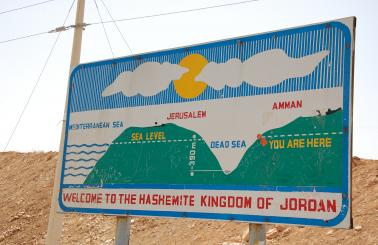 The Jordan Valley
The Jordan Valley
Spreading down the entire western side of Jordan, the Jordan Valley is perhaps the country’s most distinctive natural feature. The Jordan River runs through the valley from the north until its terminus in the Dead Sea. The valley continues south of the Dead Sea through the hot, dry Wadi Araba until it ends at the seaside city of Aqaba, Jordan’s only port.
The most popular visitation spot is, naturally, the Dead Sea. At approximately 430 meters below sea level, this is the lowest place on earth’s surface. With no outlet to the sea, intense evaporation produces a hypersaline solution that is approximately eight times saltier than the ocean – the Dead Sea’s name derives from the fact that no plants or animals can live in these salty waters. There is also a high concentration of minerals in the water, attracting visitors from all over the world with its therapeutic qualities. These visitors can also experience the magic of floating with zero effort – the salt concentration is so high that it buoys the body. In fact, the water is so dense that swimming through it is a challenge!
The Mountain Heights Plateau
In the west, there is a highland area of arable land where most of the major cities lie. This area receives Jordan’s highest rainfall, and hence is characterized by rich vegetation and fertile soil. The plateau separates the Jordan River Valley from the desert, and is intersected by numerous valleys and riverbeds known as wadis. These wadis tend to fill with water after heavy rainfall, and they all flow down to the Jordan River or the Dead Sea.
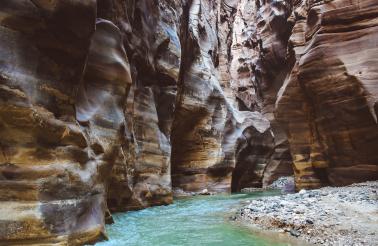 One of the most famous is Wadi Al Mujib, just an hour and a half south of Amman. This wadi ends directly at the Dead Sea, but stretches up the plateau for nearly 70 km. In many ways the canyon feels similar to the Siq in Petra – a narrow passage with towering cliffs on both sides. There are fantastic hikes to be done up the gorge.
One of the most famous is Wadi Al Mujib, just an hour and a half south of Amman. This wadi ends directly at the Dead Sea, but stretches up the plateau for nearly 70 km. In many ways the canyon feels similar to the Siq in Petra – a narrow passage with towering cliffs on both sides. There are fantastic hikes to be done up the gorge.
Another notable wadi is Wadi Dana. It lies in Dana Valley, Jordan’s largest nature reserve that is home to a wide array of wildlife and vegetation.
The Eastern Desert
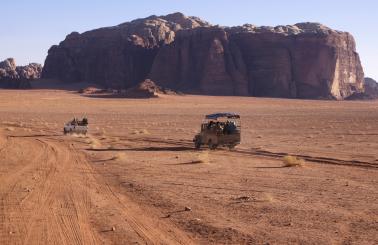 The eastern desert accounts for about 75% of the country and is part of the North Arab Desert. Despite its name, it doesn’t lie exclusively in the east of the country. Wadi Rum, for example, is more accurately described as located in the southwest. Wadi Rum displays a magnificent desert-scape in which towering sandstone mesas and granite mountains dominate and red sand stretches as far as the eye can see. It has famously been described as “vast, echoing, and god-like” by T.E. Lawrence, and it certainly lives up to its high expectations.
The eastern desert accounts for about 75% of the country and is part of the North Arab Desert. Despite its name, it doesn’t lie exclusively in the east of the country. Wadi Rum, for example, is more accurately described as located in the southwest. Wadi Rum displays a magnificent desert-scape in which towering sandstone mesas and granite mountains dominate and red sand stretches as far as the eye can see. It has famously been described as “vast, echoing, and god-like” by T.E. Lawrence, and it certainly lives up to its high expectations.

